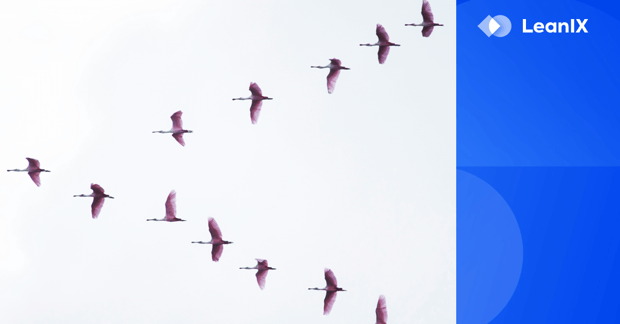
Gartner recommends a five-step framework for migrating your data to the cloud. Learn how the LeanIX enterprise architecture platform can support you in this technology transformation.
In a recent report, Gartner laid out their recommendation for migrating your company's data to the cloud. This guide documents three key stages in your technology transformation.
The stages take you through defining your strategic vision, building a target architecture, and then operationalizing that plan:
- Strategy
- Architecture
- Operationalization
Yet, these stages are broken down further into a five-step framework for data and analytics deployment in the cloud. Let's look over each of these five steps to consider how you can approach your own cloud data migration.
Data Migration Step 1: Define Migration Approaches
Before you begin your migration, you need to clarify where you're migrating to. A cloud readiness assessment can help you identify what parts of your IT landscape are ready to migrate to the cloud.
READ: Have You Completed A Cloud Readiness Assessment?
You'll need to define what data is safe to keep in the public cloud, and what you need to keep in a private cloud space. The most cost-effective method is to split your data between the two in a multi-cloud approach.
Yet, the cloud might not be right for all your data. Regulators require certain data to be kept on-premise, and performance requirements and simple practicality could make this in your interest as well.
The majority of cloud migrations will, therefore, require a complex hybrid cloud architecture with parts of your IT landscape in the public and private cloud, and on-premise. Establishing a road map to migrate to this new architecture requires the support of an enterprise architecture platform.
Data Migration Step 2: Select Data And Analytics Components
What data sources are you migrating your cloud-destined data from? You need to identify these and draw a line from where your data is now to where you want it to be.
Migrating the data along that route will often require reformatting it to a compatible state and integrating it into an organized 'data warehouse'. This way, the data can be migrated in a considered way.
Keep in mind that, working in the cloud, your data sources will be spread out across your estate. This virtualized data will need to be accessed independently of where it is stored and how.
In addition, you will need to establish new data governance and analytics to account for your new hybrid cloud landscape. You will need to look at your IT landscape in a whole new way.
Data Migration Step 3: Evaluate And Assess
Now you have your target landscape in place, it's time to check your working. How will your new landscape perform and what safeties can you put in place?
You need to examine your data storage and streams to ensure you'll have the performance and availability that you're looking for. You'll also need to confirm that your new model gives you that scalability that's the key advantage of moving to the cloud.
In the excitement of innovation, however, it can be easy to forget to be cautious. You also need to ensure you've considered security and have a disaster recovery plan in place.
Yet, what happens if, despite all your preparations, it all still goes wrong? You will also need to have a plan in place to return from the cloud to on-premise, should you need to.
Data Migration Step 4: Implementation Steps
With a complete, flexible implementation plan in place, you're ready to implement your cloud migration. Gartner recommends a six-step implementation process:
- Establish data management
- Develop data ingestion and integration
- Create data visualizations and optimizations
- Define analytical sandbox and data discovery
- Deploy enterprise reporting and analytics
- Utilize governance, metadata and data catalogs
Simply, you need to deploy everything you've prepared in your plan in the above order. Yet, this isn't the end of the task.
Data Migration Step 5: Support Transition
Your job as enterprise architects is to align your enterprise technology with your business processes and personnel. You've now completed a technology transformation, so you now need to align your business to it.
This means you need to bring your administration and support functions, and your processes, in line with your new cloud-based IT landscape. You'll also need to engage in change management to win over and align your business with your new technology landscape.
Just as you need to water and protect a flower after you replant it, so you need to nurture your business through a transformation. That's what Gartner prescribes for cloud migration success.
How LeanIX Can Support Your Migration
The most vital part of Gartner's strategy for cloud data migration is the planning stage. Planning actually takes up the bulk of the work.
A complex spreadsheet or PowerPoint deck isn't going to offer you the functionality that you need to plan a migration effectively within the timeframe you have allotted. To properly road map your cloud data migration, you need a tool that's designed to support technology transformation.
The LeanIX Application Portfolio Management product tracks complete information about your entire application portfolio and IT landscape. It can support you in completing a cloud readiness assessment by tracking information such as:
- business objectives
- application descriptions and dependencies
- application performance
- the owner of each application and stakeholders
- where each application pulls its data from
Combined with the LeanIX Architecture and Road Map Planning product, you can then create a road map and timelines for your cloud data migration that's informed by all your above data. This gives you a tool in which you can model and manipulate your cloud architecture to create the perfect plan.
To find out more, read Gartner's report on choosing the right approach to cloud migration with LeanIX:


